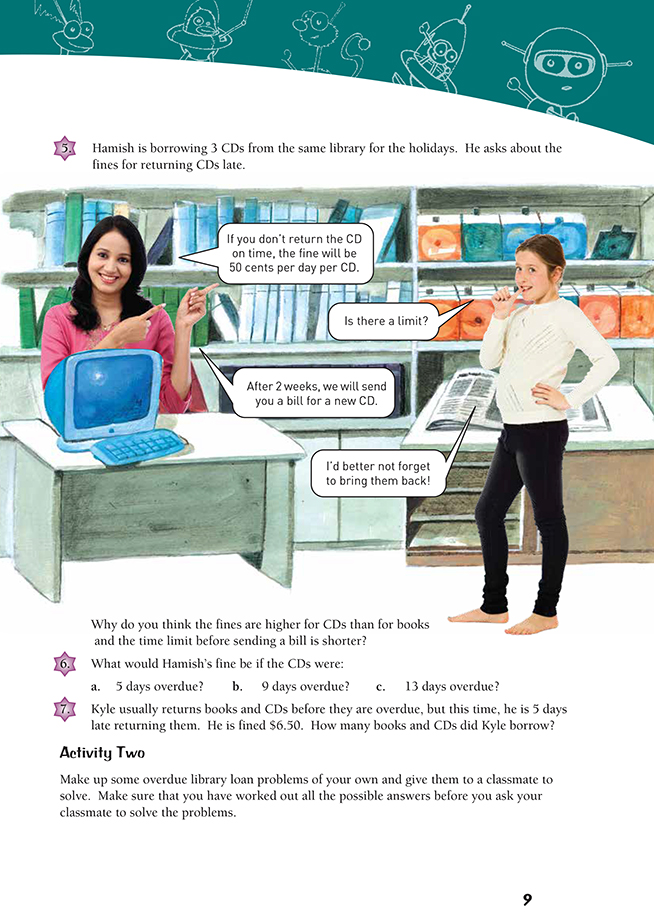This is a level 4 number activity from the Figure It Out series. It relates to Stage 7 of the Number Framework.
A PDF of the student activity is available.
Click on the image to enlarge it. Click again to close. Download PDF (399 KB)
solve money problems involving multiplication and division
FIO, Level 3, Number, Book 2, Booked! pages 8-9
A classmate
Activity One
This activity presents a multiplication scenario that combines 3 factors to get a result.
In their initial discussion, the students could work in problem-solving groups of four and focus on understanding the problem. Have them report back on the numbers involved in question 1a and how they relate to each other (that is, the 3 books, the 10 cents, and the 10 days work together as factors, not addends).
After the students have solved the problem, discuss the strategies used. In question 1a, the factors are 3 x 10 x 10 = 300 cents or $3. Some students would multiply left to right (3 x 10 = 30, then 30 x 10 = 300), while others would multiply right to left (10 x 10 = 100; this is $1, so 3 x 1 = $3).
It is good practice to ensure that the students change the 300 cents into $3 because that is the most economical form.
Questions 1b and 1c have only one factor of 10, whereas 1a has two factors of 10. Encourage the students to see the effect of multiplying by 10 on the place value of the other factor. Question 1c, where the equation is 3 x 23 x 10, can be solved by doing 3 x 23 = 69, then 69 x 10 = 690. Ask them to notice how the 69 moves one place to the left to become 690.
This effect can be shown on a calculator when the students enter 10 x 69 and watch the display as they press the equals button. They can then use the constant function to multiply by 10 repeatedly by pressing = a number of times and watch the digits move one place to the left each time. (On some calculators, the students will need to enter 10 x x 69 before they can use the constant function.)
If the students say “To multiply by 10, we add a 0”, challenge this language by asking them to add 0 to 69. The answer, of course, is 69 (69 + 0 = 69). The digits remain where they are. This linguistic short cut can confuse students about the properties of adding 0 and multiplying by 10.
The students show good understanding if they can say “Because the digits have moved 1 place to the left, we put a 0 in the vacant ones place.”
You may wish to extend this concept to multiplying by a factor of 100 or 1 000.
An interesting strategy can be used in question 2 if the students realise that $3.60 is 36 x 10 cents.
The combination of books and days are the only variables, and so the factors of 36 provide the solution.
Question 3 is a useful context for logical thinking. Ensure that the students discuss their reasoning and focus on the sensibleness of their conclusions.
Question 7 is a challenge because there are now two variables to consider. The overdue days are constant at 5, but it is the mix of books and CDs that needs to be explored.
You may need to help the students to work out a way to show all possible combinations of books and CDs that make a fine of $6.50 over 5 days. For example,
An alternative strategy would be to find the fine per day: $6.50 for 5 days is therefore $1.30 for 1 day. $1.30 can be made up only of 1 CD and 8 books or 2 CDs and 3 books. A maximum of 7 books can be borrowed, so the solution is 2 CDs and 3 books.
Activity Two
In this activity, the challenge is for the students to make sure that the problems they make up do, in fact, have sensible answers. They also need to take account of other possible answers.
Answers to Activities
Activity One
1. a. $3
b. $4.50
c. $6.90
2. Either 6 books overdue by 6 days, 4 books overdue by 9 days, 3 books overdue by 12 days, or 2 books overdue by 18 days
3. Discussion could include the cost to the library of replacing lost books, fairness to other readers who are waiting to read the overdue books, and helping to pay the library’s running costs.
4. Practical activity
5. Answers will vary. Possible answers include: CDs usually cost more to replace than books; libraries have fewer CDs than books, and there is generally a long waiting list for the more popular CDs; and CDs are smaller than books and may get lost more easily, so the libraries want people to remember they have them and return them.
6. a. $7.50
b. $13.50
c. $19.50
7. 2 CDs and 3 books
Activity Two
Problems and solutions will vary.



